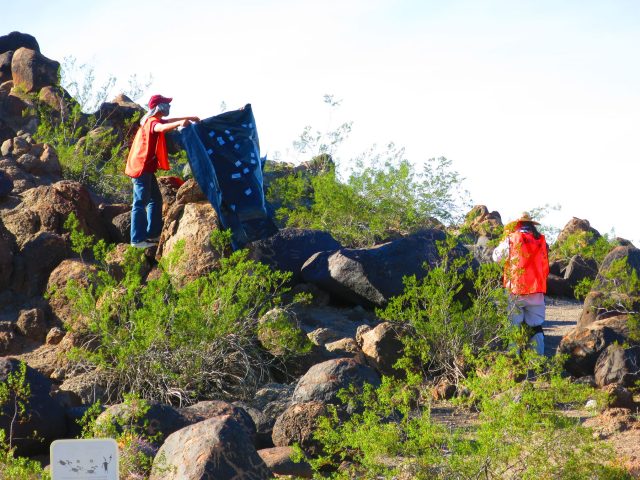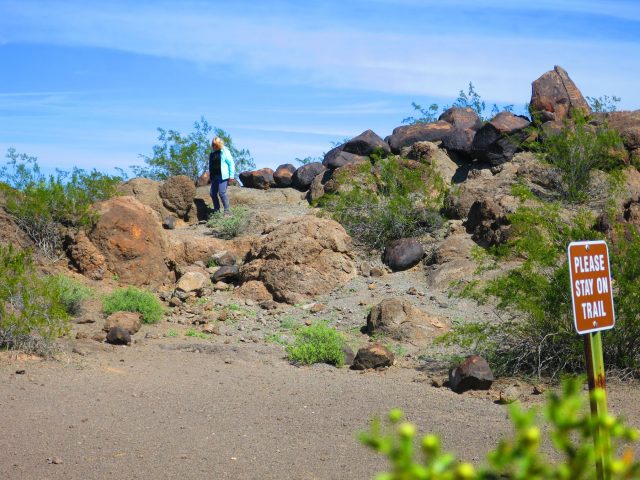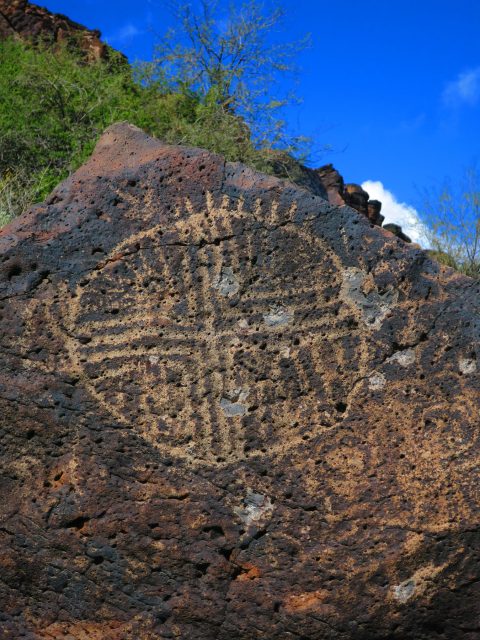- Home
- >
- Preservation Archaeology Blog
- >
- Protecting Native Rock Art: Be a Good Guest!
Kirk Astroth, Archaeology Southwest Member and Volunteer
(March 3, 2017)—For the past 7 weeks, a team of us (Jaye Smith, Carl Evertsbusch, Fran Maiuri, Lance Trask, and I) have been working under the guidance of Aaron Wright to document the 594 boulders at the Painted Rock Petroglyph Site. I have found the work invigorating, the company stimulating, and the learning incredible. I’ve been to the site before, yet I never really “saw” it as I am seeing it now.

But it has been particularly disappointing to see all the modern graffiti and degradation at the site because of increased visitation. Graffiti dates from at least 1879 up to 2013. Many of those who started to try and leave their marks on the rocks found out, I think, how hard this really is and that the native people who left us their artwork were far more skilled than modern contemporaries.
Occasionally, out at the site, we have people who ignore the signs and warnings who only contribute to the site’s degradation. One day, a motorcyclist drove through the walkway gate near the pay station and then nearly drove up into the boulders before the campground host was able to get him to stop. Still, he parked his motorcycle next to an information board and then proceeded to walk up into the boulders anyway, despite our protests and pleas. After a few minutes of gawking, he got back on his motorcycle and then, rather than returning the way he came, he chose to drive over the area that I was surveying, trying to find a way out of the BLM site. Eventually he left—possibly to cause more havoc elsewhere.

On another occasion, while we were photographing the boulders, we looked up to see a woman up near the top of the site, walking around in the boulders and taking photos. We asked her to get off the rocks and return to the trail. Despite our repeated pleas, she only slowly got down, all the while taking more photos along the way. A couple of people in the campground came over and shared their frustration with people like her who won’t stay on the established trails and stay off the boulders. Eventually she said: “This place is so eroded anyway, I don’t know why you are bothering to preserve the place.” I could only laugh at such an absurd comment.
For a site that has been there for at least 1,500 years, Painted Rock is holding up pretty well despite vandalism, graffiti, and the close proximity of a campground at the site. Our RASI (Rock Art Stability Index) work documents that most of the boulders are in pretty good shape, but those closest to the trail show more wear than others further away. Given that there is no campground host during part of the year, it is amazing that the site is still so well preserved, in my opinion.

But the threats to rock art are constant. Recently I was able to participate in another survey of a site along the Gila River where we saw over 1,000 petroglyphs on numerous panels. A beautiful shield image, however, was damaged by at least seven bullet holes. Preservation is critical to saving these images, and that is why our work will hopefully result in monument designation for the Great Bend of the Gila River.
Some people don’t see rock art as anything more than ancient “graffiti,” but it really is so much more. Although we may never really know what these images mean, they represent human artistic and spiritual expressions. Protecting them and documenting them is critical. I am proud to be part of this work along the Gila River and hope that one day we will see a monument that will help protect the numerous images, sites, ballcourts, and other artifacts found along this ancient highway.
3 thoughts on “Protecting Native Rock Art: Be a Good Guest!”
Comments are closed.
Explore the News
Related to This
-
Location Painted Rock Petroglyph Site
Aaron and crew. Thanks for your hard work to document and preserve the rock art sites of the Gila River. Thank you.
Excellent article, Kirk. Hopefully, it will help make people aware of the necessity to preserve and protect these ancient sites.
Kirk and the rest of the team, thanks SO MUCH for your efforts and concerns and diligence. Hats off to all of you.